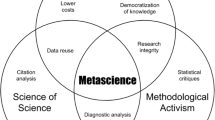Abstract
This essay introduces a special collection of papers by Angela Creager, Soraya de Chadarevian, Karen Rader, Jean-Paul Gaudillière, and María Jesús Santesmases on the theme “Radiobiology in the Atomic Age.”
Similar content being viewed by others
References
Abir-Am Pnina G. (1982) “The Discourse of Physical Power and Biological Knowledge in the 1930s: A Reappraisal of the Rockefeller Foundation’s ‚Policy’ in Molecular Biology.” Social Studies of Science 12:341–382
Beatty John. (1991) “Genetics in the Atomic Age: The Atomic Bomb Casualty Commission, 1947–1956.” In: Keith R. Benson, Jane Maienschein and Ronald Rainger (eds.), The Expansion of American Biology. Rutgers University Press: New Brunswick, NJ pp. 284–324
Bocking Stephen (1995) “Ecosystems, Ecologists, and the Atom: Environmental Research at Oak Ridge National Laboratory.” Journal of the History of Biology 28:1–4
Bocking Stephen. (1997) Ecologists and Environmental Politics: A History of Contemporary Ecology. Yale University Press: New Haven, CT
de Chadarevian Soraya. (2002) Designs for Life: Molecular Biology after World War II. Cambridge University Press: Cambridge
Doel Ronald E. (1997) “Scientists as Policymakers, Advisors, and Intelligence Agents: Linking Contemporary Diplomatic History with the History of Contemporary Science”. In: Thoma Söderqvist (ed.), The Historiography of Contemporary Science and Technology. Harwood: Amsterdam pp. 215–244
Evans Robley D. (1946) “The Medical Uses of Atomic Energy.” Atlantic 177 (Jan. 1946):68–73
Forman Paul. (1987) “Behind Quantum Electronics: National Security as Basis for Physical Research in the United States, 1940–1960.” Historical Studies in the Physical and Biological Sciences 18:149–229
Fragu Philippe. (2003) “How the Field of Thyroid Endocrinology Developed in France after World War II.” Bulletin of the History of Medicine 77:393–414
Gaudillière Jean-Paul. (2002) Inventer la biomédecine: La France, l’Amérique et la production des saviors du vivant (1945–1965). éditions la Découverte: Paris
Gaudillière, Jean-Paul and Löwy, Ilana, eds. 1998. The Invisible Industrialist: Manufactures and the Production of Scientific Knowledge. Macmillan: London
Gowing Margaret (1974) Independence and Deterrence: Britain and Atomic Energy, 1945–1952, 2 vols. Macmillan:London
Hacker Barton C. (1994) Elements of Controversy: The Atomic Energy Commission and Radiation Safety in Nuclear Weapons Testing, 1947–1974. University of California Press: Berkeley, CA
Hecht Gabrielle. (2002) “Rupture-Talk in the Nuclear Age: Conjugating Colonial Power in Africa.” Social Studies of Science 32:691–727
Hewlett, Richard G. and Duncan, Francis. 1990 (1969). Atomic Shield: A History of the United States Atomic Energy Commission, Volume II 1947–1952. Berkeley, CA: University of California Press; originally published: University Park, PA: Pennsylvania University Press
Hollaender, Alexander. 1963. “Acceptance Speech.” Michael Ebert and Alma Howard (eds.), Radiation Effects in Physics, Chemistry and Biology. Chicago: Year Book Medical Publishers, pp. vii–x
Jolly, J. Christopher. 2003. “Thresholds of Uncertainty: Radiation and Responsibility in the Fallout Controversy.” Ph.D. dissertation, Oregon State University
Josephson Paul. (2000) Red Atom: Russia’s Nuclear Power Program from Stalin to Today. W. H. Freeman :New York
Kaiser David. (2005) Training and the Generalist’s Vision in the History of Science. Isis 96:244–251
Kay Lily E. 1993 The Molecular Vision of Life: Caltech, The Rockefeller Foundation, and the Rise of the New Biology. Oxford University Press:New York
Keller Evelyn Fox. (1990) “Physics and the Emergence of Molecular Biology: A History of Cognitive and Political Synergy.” Journal of the History of Biology 23:389–409
Keller Evelyn Fox. (1992) “From Secrets of Life to Secrets of Death.” In Secrets of Life, Secrets of Death: Essays on Language, Gender, and Science. Routledge: New York pp. 39–55
Kevles Daniel J. (1990) “Cold War and Hot Physics: Science, Security, and the American State, 1945–56” Historical Studies in the Physical and Biological Sciences 20:239–264
Kevles, Daniel J. and Geison, Gerald L. 1995. “The Experimental Life Sciences in the Twentieth Century.” Osiris 10: 97–121, 233–241
Kohler Robert E. 1991. Partners in Science: Foundations and Natural Scientists, 1900–1945. University of Chicago Press:Chicago
Kraft Alison. (2006) “Between Medicine and Industry: Medical Physics and the Rise of the Radioisotopes 1945–65.” Contemporary British History 20:1–35
Krige John. (2006) “Atoms for Peace, Scientific Internationalism and Scientific Intelligence.” Osiris 21:161–181
Lenoir, Timothy and Hays, Marguerite. 2000. “The Manhattan Project for Biomedicine.” Philip R. Sloan (ed.), Controlling Our Destinies: Historical, Philosophical, Ethical, and Theological Perspectives on the Human Genome Project. Notre Dame, IN: University of Notre Dame Press, pp. 29–62
Lindee Susan M. (1994) Suffering Made Real: American Science and the Survivors at Hiroshima. University of Chicago Press:Chicago
Muller H.J. (1927) “Artificial Transmutation of the Gene.” Science 66:84–87
Rader Karen A. (2004) Making Mice: Standardizing Animals for American Biomedical Research, 1900–1955 Princeton University Press: Princeton, NJ
Rasmussen Nicolas. (1997) “The Mid-Century Biophysics Bubble: Hiroshima and the Biological Revolution in America, Revisited.” History of Science 35:245–293
Strasser, Bruno J. 2002. “Les Sciences de la Vie a l’Age Atomique. Identités, pratiques et alliances dans la construction de la biologie moléculaire á Genève (1945–1970),” Ph.D. dissertation, Université de Genève, Université de Paris 7
U.S. Atomic Energy Commission. 1952. Some Applications of Atomic Energy in Plant Science. Washington, D.C.: U.S. Government Printing Office
Author information
Authors and Affiliations
Corresponding author
Rights and permissions
About this article
Cite this article
Creager, A.N.H., Santesmases, M.J. Radiobiology in the Atomic Age: Changing Research Practices and Policies in Comparative Perspective. J Hist Biol 39, 637–647 (2006). https://doi.org/10.1007/s10739-006-9107-3
Published:
Issue Date:
DOI: https://doi.org/10.1007/s10739-006-9107-3




